 Applied Mathematics, 2011, 2, 1068-1075 doi:10.4236/am.2011.29148 Published Online September 2011 (http://www.SciRP.org/journal/am) Copyright © 2011 SciRes. AM Positive Solutions to the Nonhomogenous p-Laplacian Problem with Nonlinearity Asymptotic to at Infinity in 1p u N Li Wang School of Mathematics and Statistics, Huazhong Normal University, Wuhan, China E-mail: wangli.423@163.com Received March 20, 2011; revised June 6, 2011; accepted June 13, 2011 Abstract In this paper, we study the following problem 2 1, || in , , 0 in , N p pN N uVxuu Kxfuhx uW u (*) where , the potential is a positive bounded function, 1pN Vx , pN hL 11 1, 1, 0, pNh pp 0,h s is nonlinearity asymptotical to 1 at infinity, that is, ~fs Os1p as . The aim of this paper is to discuss how to use the Mountain Pass theorem to show the existence of positive solutions of the present problem. Under appropriate assumptions on and , we prove that problem (*) has at least two positive solutions even if the nonlinearity , , hVK f s does not satisfy the Ambrosetti-Rabinowitz type condition: 0 1 0d, 0 ,0 u Fufssf uuu p . Keywords: Positive Solutions, p-Laplacian, Nonlinearity Asymptotic, Mountain Pass Theorem 1. Introduction and Preliminaries In this paper, we study the following problem 2 1, in , , 0 in , p p pN N uVxuu Kxfuhx uW u (1.1) where 2 div, , 11 1, 1, 0, 0, ppN puuuhL pNh h pp and the function and , VK satisfy the following conditions: 1 V , , aA : N V , 0B is continuous and there exist such that 1 aVx A x . 1 ,ft C , if 0ft0.t 2 +1 0 lim 0 p t ft . t 3 There exists , 1qpp ,such that lim 0 q n ft , where Np pNp . t 4 1 + lim 1, p t ft l t . 1 Kis a positive continuous bounded function and there exists > 0 such that 0 R 0 1 sup:0 inf:. p fs Vx sx Kx s R Throughout this paper, we define the following Weighted Sobolev space 1, :d N p pN p Wu uVxux 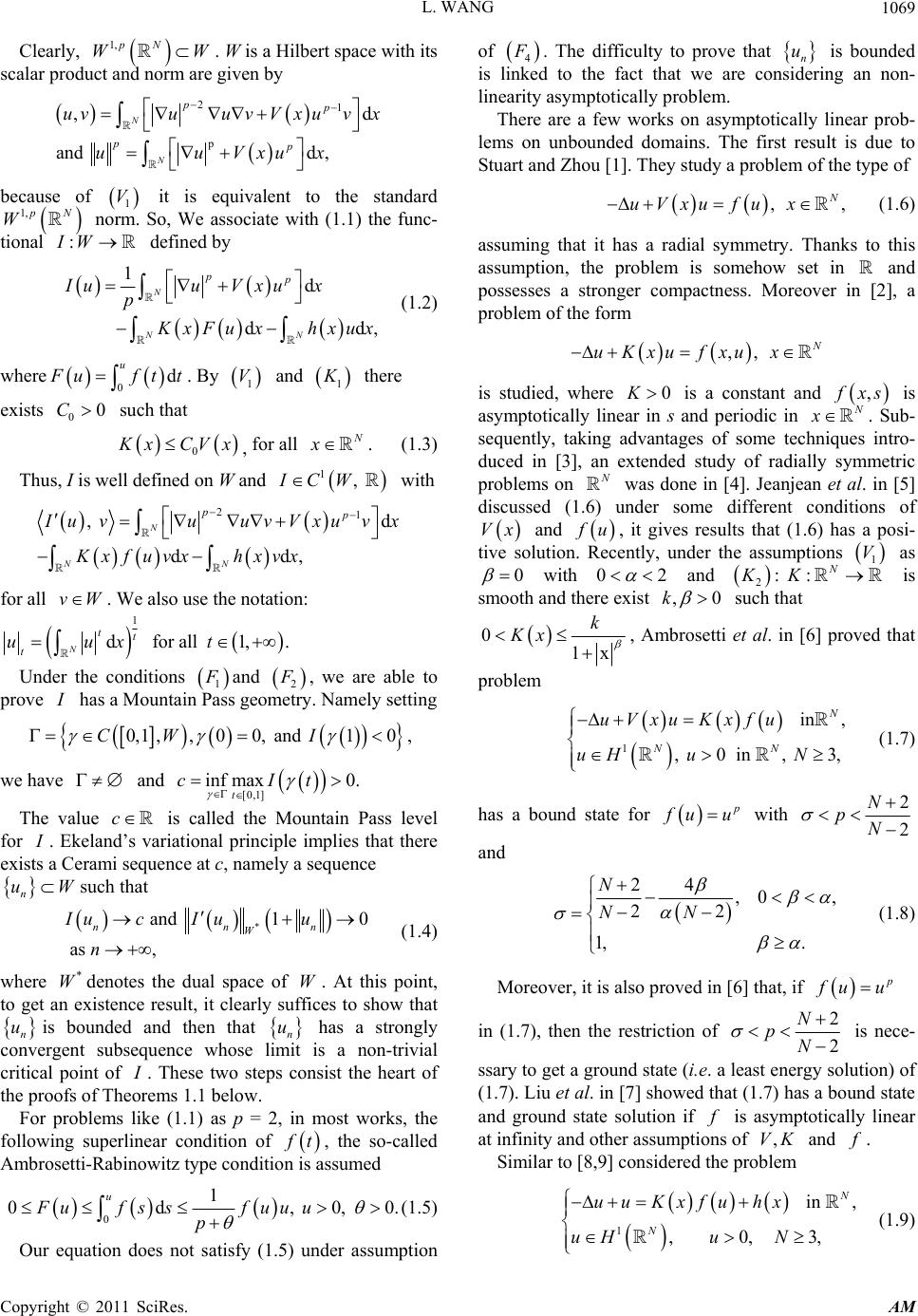 L. WANG1069 WClearly, . W is a Hilbert space with its scalar product and norm are given by 1, pN W 21 p , andd , N N pp pp uvuu vVxuvx uuVxux d because of it is equivalent to the standard 1 V 1, N W :IW norm. So, We associate with (1.1) the func- tional defined by 1d dd N NN pp IuuVxux p , xFu xhxux (1.2) where 0d u uftt. By 1 V and 1 there exists such that 00C 0 xCVx, for all x. (1.3) Thus, I is well defined on W and with 1, ICW 21 , d dd, N NN pp uvu uvVxuvx K xfuvxhxvx for all . We also use the notation: vW 1 d for all 1,. N tt t uux t Under the conditions 1 and 2 , we are able to prove has a Mountain Pass geometry. Namely setting 0,1 ,,00,and10CW I , we have and [0,1] inf max0. t cIt The value is called the Mountain Pass level for c . Ekeland’s variational principle implies that there exists a Cerami sequence at c, namely a sequence such that u nW * and 10 as , nnn W IucI uu n (1.4) where denotes the dual space of . At this point, to get an existence result, it clearly suffices to show that is bounded and then that n has a strongly convergent subsequence whose limit is a non-trivial critical point of * W W n u u . These two steps consist the heart of the proofs of Theorems 1.1 below. For problems like (1.1) as p = 2, in most works, the following superlinear condition of t, the so-called Ambrosetti-Rabinowitz type condition is assumed 0 1 0d, 0 ,0 u Fufssf uuu p . (1.5) Our equation does not satisfy (1.5) under assumption of 4 . The difficulty to prove that is bounded is linked to the fact that we are considering an non- linearity asymptotically problem. n u There are a few works on asymptotically linear prob- lems on unbounded domains. The first result is due to Stuart and Zhou [1]. They study a problem of the type of , , uVxu fux (1.6) assuming that it has a radial symmetry. Thanks to this assumption, the problem is somehow set in and possesses a stronger compactness. Moreover in [2], a problem of the form ,, uKxu fxux is studied, where is a constant and 0K , xs is asymptotically linear in s and periodic in x. Sub- sequently, taking advantages of some techniques intro- duced in [3], an extended study of radially symmetric problems on was done in [4]. Jeanjean et al. in [5] discussed (1.6) under some different conditions of N Vx and u, it gives results that (1.6) has a posi- tive solution. Recently, under the assumptions 1 V as 0 with 02 k and is smooth and there exist 2: :KK 0 N , such that 0 1x k Kx , Ambrosetti et al. in [6] proved that problem 1 in, , 0 in , 3, NN uVxu Kxfu uH uN (1.7) has a bound state for fu u with 2 2 N pN and 24 , 0, 22 1, . N NN (1.8) Moreover, it is also proved in [6] that, if uu in (1.7), then the restriction of 2 2 N pN is nece- ssary to get a ground state (i. e. a least energy solution) of (1.7). Liu et al. in [7] showed that (1.7) has a bound state and ground state solution if is asymptotically linear at infinity and other assumptions of and ,VK . Similar to [8,9] considered the problem 1 in , , 0, 3, N uu Kxfuhx uHu N (1.9) Copyright © 2011 SciRes. AM 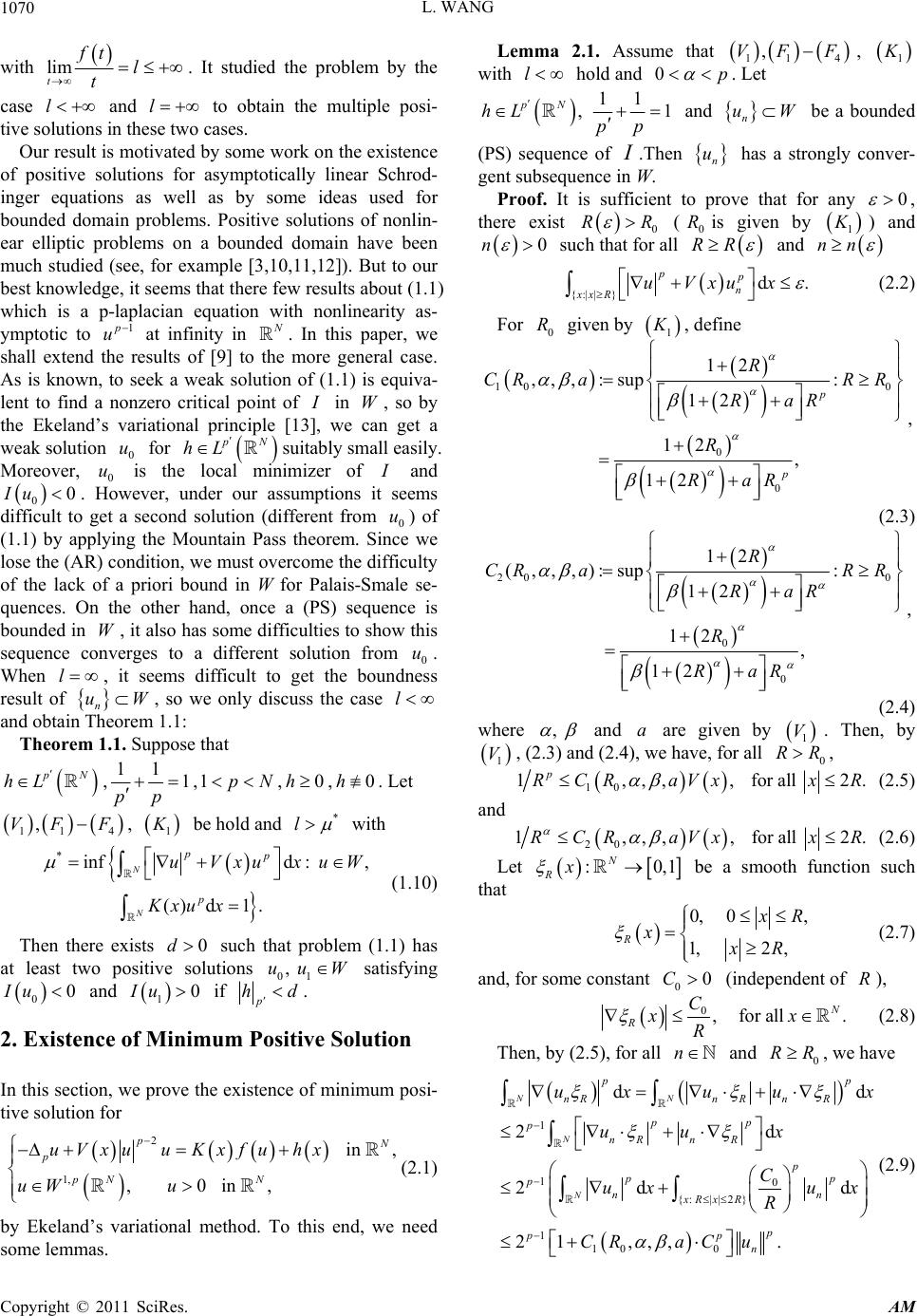 L. WANG 1070 with lim t ft l t . It studied the problem by the case and to obtain the multiple posi- tive solutions in these two cases. ll Our result is motivated by some work on the existence of positive solutions for asymptotically linear Schrod- inger equations as well as by some ideas used for bounded domain problems. Positive solutions of nonlin- ear elliptic problems on a bounded domain have been much studied (see, for example [3,10,11,12]). But to our best knowledge, it seems that there few results about (1.1) which is a p-laplacian equation with nonlinearity as- ymptotic to 1 u at infinity in . In this paper, we shall extend the results of [9] to the more general case. As is known, to seek a weak solution of (1.1) is equiva- lent to find a nonzero critical point of in , so by the Ekeland’s variational principle [13], we can get a weak solution 0 for W u Np hL suitably small easily. Moreover, 0 is the local minimizer of u and . However, under our assumptions it seems difficult to get a second solution (different from 0) of (1.1) by applying the Mountain Pass theorem. Since we lose the (AR) condition, we must overcome the difficulty of the lack of a priori bound in W for Palais-Smale se- quences. On the other hand, once a (PS) sequence is bounded in , it also has some difficulties to show this sequence converges to a different solution from 0. When , it seems difficult to get the boundness result of , so we only discuss the case 00Iu l u l W n u u W and obtain Theorem 1.1: Theorem 1.1. Suppose that pN hL ,11 1 pp ,1,,. Let pN 0h0h 11 4 ,VF F, 1 be hold and * l with *infd: , ()d1. N N pp p uVxuxuW Kxux (1.10) Then there exists such that problem (1.1) has at least two positive solutions satisfying and if 0d 1001 , uuW 00Iu Iu p hd . 2. Existence of Minimum Positive Solution In this section, we prove the existence of minimum posi- tive solution for 2 1, in , , 0 in , p p pN N uVxuu Kxfuhx uW u (2.1) by Ekeland’s variational method. To this end, we need some lemmas. Lemma 2.1. Assume that , 11 4 ,VF F 1 with l hold and 0p . Let 11 , 1 pN hL pp and be a bounded n uW (PS) sequence of .Then has a strongly conver- gent subsequence in W. n u Proof. It is sufficient to prove that for any 0 , there exist 0 RR (is given by 0 R 1 ) and 0n such that for all RR and nn {:|| }d pp n xx RuVxux. (2.2) For given by 0 R 1 , define 10 0 0 0 12 ,,, :sup: 12 12 , 12 p p R CRaR R RaR R RaR , (2.3) 20 0 0 0 12 (,,,):sup: 12 12 , 12 R CRaR R RaR R RaR , (2.4) where , and are given by a 1 V. Then, by 1 V, (2.3) and (2.4), we have, for all , 0 RR 10 ,,, for 2.R aVxR, all p RC x1 (2.5) and 20 1,,,, for all 2.RCRaVxxR (2.6) Let :0N Rx ,1 be a smooth function such that 0, 0, 1, 2, R R xxR (2.7) and, for some constant (independent of ), 00CR 0, for all . R C xx R (2.8) Then, by (2.5), for all n and , we have 0 RR 1 10 {: ||2} 1 10 0 dd 2d 2d 21 ,,,. NN N N pp nRn RnR pp p nRn R p pp p nn xR xR p pp n ux uu uu x C ux ux R CRaC u d x (2.9) Copyright © 2011 SciRes. AM 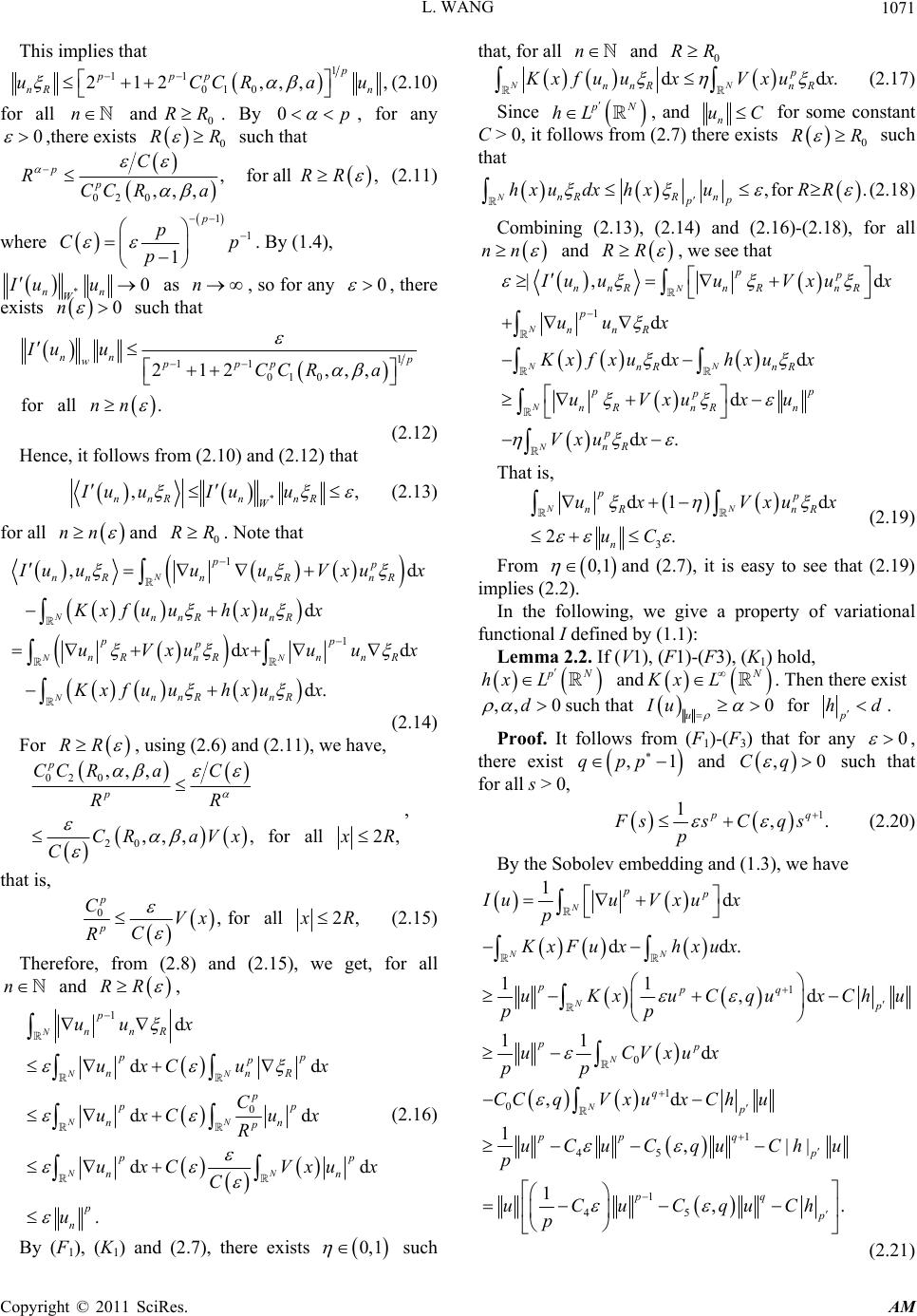 L. WANG1071 This implies that 1 11 01 0 212 ,,,p ppp nR n uCCRa ,u (2.10) for all and . By n0 RR0p , for any 0 ,there exists such that 0 R R 02 0 , for all , ,,, p p C RR CC Ra R (2.11) where 1 1 1 p p Cp p . By (1.4), *0 nn W Iu u as , so for any n 0 , there exists such that 0n 1 11 010 212 ,,, for all. nn wppp Iu u CC Ra nn (2.12) Hence, it follows from (2.10) and (2.12) that * ,, nnRn nR W Iu uIuu (2.13) for all nn and . Note that 0 RR 1 1 ,d d dd d. N N NN N pp nnRnnRnR nnR nR pp p nRnRn nR nnR nR uuuuVxu x Kxfu uhxux uVxux uux Kxfu uhxux (2.14) For RR , using (2.6) and (2.11), we have, 02 0 20 ,, p CC R , ,,,,forall 2, p aC RR CRaVxxR C , that is, 0,forall2, p p CVxxR C R (2.15) Therefore, from (2.8) and (2.15), we get, for all and n RR , 1 0 d dd dd dd . N NN NN NN p nnR pp p nnR p pp nn p pp nn p n uu x uxC ux C uxC ux R uxC Vxu C u x (2.16) By (F1), (K1) and (2.7), there exists 0,1 such that, for all n and 0 RR dd. p nnR nR NN xfu uVxu x x (2.17) Since N p hL , and n uC for some constant C > 0, it follows from (2.7) there exists such that 0 R R ,for . NnRRn p p hxudx hxuRR (2.18) Combining (2.13), (2.14) and (2.16)-(2.18), for all nn and RR , we see that 1 |, d dd d d. N N NN N N pp nnRnR nR p nnR nR nR pp p nR nRn p nR d uuuVxu x uu x Kxf xuxhxux uVxuxu Vxu x That is, 3 d1 d 2. NN pp nR nR n ux Vxu uC x (2.19) From 0,1 and (2.7), it is easy to see that (2.19) implies (2.2). In the following, we give a property of variational functional I defined by (1.1): Lemma 2.2. If (V1), (F1)-(F3), (K) hold, 1 pN hx L and Kx L . Then there exist ,, 0d such that 0Iu for p hd . u Proof. It follows from (F1)-(F3) that for any 0 , there exist ,1qpp and such that for all s > 0, ,Cq 0 1 1, p. q ssCqs p (2.20) By the Sobolev embedding and (1.3), we have 1 0 1 0 1 45 1 45 1d dd. 11 ,d 11 d ,d 1,|| 1,. N NN N N N pp ppq p pp q p pp q p pq p IuuVxux p KxFu xhxux uKxuCquxCh pp uCVxux pp CCqVx uxChu uCuCquChu p uCuCquCh p u (2.21) Copyright © 2011 SciRes. AM  L. WANG 1072 Taking 4 1 2Cp and setting 1 5 1, 2 q ttCq p t0 for t, we see that there exists 0 such that 0t max tgd 0 . Then it follows from (2.21) that there exists such that || ||0 u Iu for p hd . Theorem 2.1. Assume that (V1), (F1)-(F4), (K1) hold, , , pN hx L 0hx 0hx . Let u:BuW ,if p hd ,,d is given by Lemma 2.2, then there exists 1, 0 N uW such that 0inf:0,IuIu uB and is a positive solution of problem (1.1). 0 Proof. Since , and u pN hx L 0hx 0hx , we can choose a function W such that d0 Nhxxx . (2.22) For , we have 0t d dd d0, N NN N ppp pp t ItVx x p xFtxthxxx tthx xx p for small enough. Hence 0t 0 : 0cIuuB: inf . By the Ekeland’s vari- ational principle, there exists n uB such that 00 1 1) , 1 2) forall . n nn cIu cn wIu wuwB n Then by a standard procedure, see for example [14], we can show that is a bounded (PS) sequence of I. Hence Lemma 2.1 implies that there exists n u 1, 0 N uW such that 00Iu and . 00 0Iuc 3. Existence of Second Solution Next we prove that problem (1.1) has a Mountain Pass type solution. For this purpose, we use a variant version of Mountain Pass theorem ([13] Chapter IV), which allows us to find a so-called Cerami type (PS) sequence. The properties of this kind of (PS) sequence are very helpful in showing its boundedness. The following lemma shows that I defied in (1.1) has the so-called Mountain Pass geometry. Lemma 3.1. Let , 11 4 ,VF F 1 be hold and * l with * given by (1.10). Then there exists vW with v , is given by Lemma 2.2, such that Iv 0 . Proof. By the definition of * and * l , we can choose a nonnegative function W such that 0 d1and d. p pp x Vxxl * N N Kx Therefore, by (F4) and Fatou’s lemma, we deduce that 1 lim It lim d 1 lim( )d 11 0. N N p pp tt p t p Ft xx p tt hxtx t l pp So the lemma is proved by taking 0 vt with large enough. 01t From Lemma 2.2 and Lemma 3.1, there is a sequence n uW such that * lim and lim10. nnn W nn cI uu Iu (3.1) For this sequence n u, let n n n u wu . Clearly, n is bounded in and there is a wWwW such that, up to a subsequence, * weakly in , a.e. in , strongly in () for <. N qN nl oc W L pqp ww ww ww n n(3.2) For the above w, we have the following lemma. Lemma 3.2. Let 11 4 ,VF F, 1 hold, 0, pl, * for * given by (1.10). If n u as , then w given by (3.2) is a nontrivial nonnegative solution of n 21, . pp pu Proof. Le x V The p xuxuxlKxuu W roof of this lemma is similar to that of ([ that w is nontrivial, that is (3.3) 7] mma 2.4). For the sake of completeness, we give a simple proof here. Step 1. We claim 0w . By contradiction, if 0w , we claim that 1 li n (3.4) is tru m supd1. N np n p n Kx wx u (3.4) e, then it leads to a contradiction fu If immediately. Indeed, since n u, it follows from (3.1) that Copyright © 2011 SciRes. AM 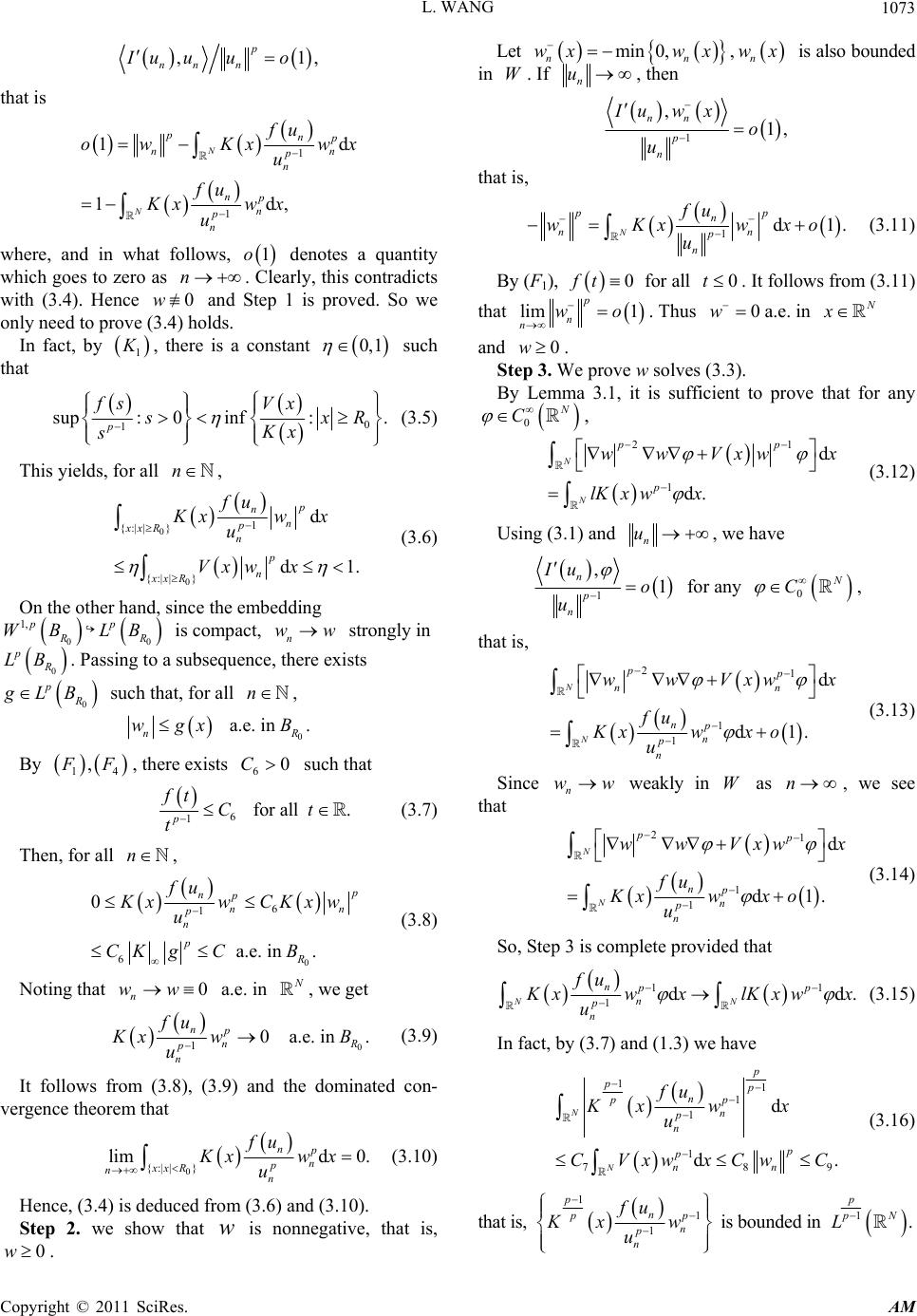 L. WANG1073 ,1 p nn n Iu uuo , that is 1 1 1d 1d N N pnp nn p n np n p n fu owKxw u fu Kxw x u , x where, and in what follows, denotes a quantity 3.4) h 1o . Cle which goes to zero as n arly, this contradicts with (3.4). Hence w Step 1 is proved. So we only need to prove (olds. In fact, by 1 0 and , there is a constant such th 0,1 at 0 1 sup: 0inf:. p fs Vx sx Kx s R (3.5) This yields, for all n, 0 0 1 {:|| } {:|| } d d p n n p xx R n p n xx R1 . u Kx w x u Vxw x (3.6) On the other hand, since the embedding strongly in f 1, pB↪ p LB is compact, n ww a subsequence,ists 0 R W p LB 0 R . Passing to 0 R p there ex 0 R LB such that, for all n, a. nR wgx0.B By e. in 14 , F, there exists such that 60C 6 1 for all . p ft Ct t (3.7) Then, for all n, 0 6 1 6 0 a.e. in . np nn p n p R fu xwCKxw u CK gCB (3.8) Noting that a.e. in , we get 0 n ww N 0 10 a.e. in . np nR p n fu xw B u (3.9) It follows from (3.8), (3.9) and the dominated con- vergence theorem that 0 {:|| } limd 0. np n p xx R nn fu Kxw x u (3.10) Hence, (3.4) is deduced from (3.6) and (3.10). that is, Let Step 2. we show that w is nonnegative, 0. w min 0, nn x wx , f w n wx is also bounded in W. In u, then 1 , 1, nn p n Iuw x o u that is, 1d1 N pp n nn p n fu wKxwxo u . (3.11) By (F), 1 0ft for all . It follows from (3.11) th 0t at lim 1wo. Thus 0a.e. in p w x n n and 0w. Step 3. We prove w solves (3.3). prove that for any By Lemma 3.1, it is sufficient to 0N C , 21 1 d d. N N pp p wwVxw lKx wx x (3.12) Using (3.1) and n u, we have 1 ,Iu 1 n p n o u for any that is, 0N C , 21 1 1 d d1. N N pp nn np n p n wwVxw fu Kxwx o u x (3.13) Since weakly in as we see th n wwW n, at 21 1 1 d d1. N N pp np n p n wwVxw fu Kxwx o u x (3.14) So, Step 3 is complete provided that 11 1dd NN npp n p n fu .xwxlKxwx u (3.15) In fact, by (3.7) and (1.3) we have 11 1 1 1 78 d d. N N9 p np p n p n p p nn fu Kxw x u CVxwxCw C (3.16) that is, p p 1 1 1 p np p n p n fu Kx w u is bounded in 1 p p L. Copyright © 2011 SciRes. AM 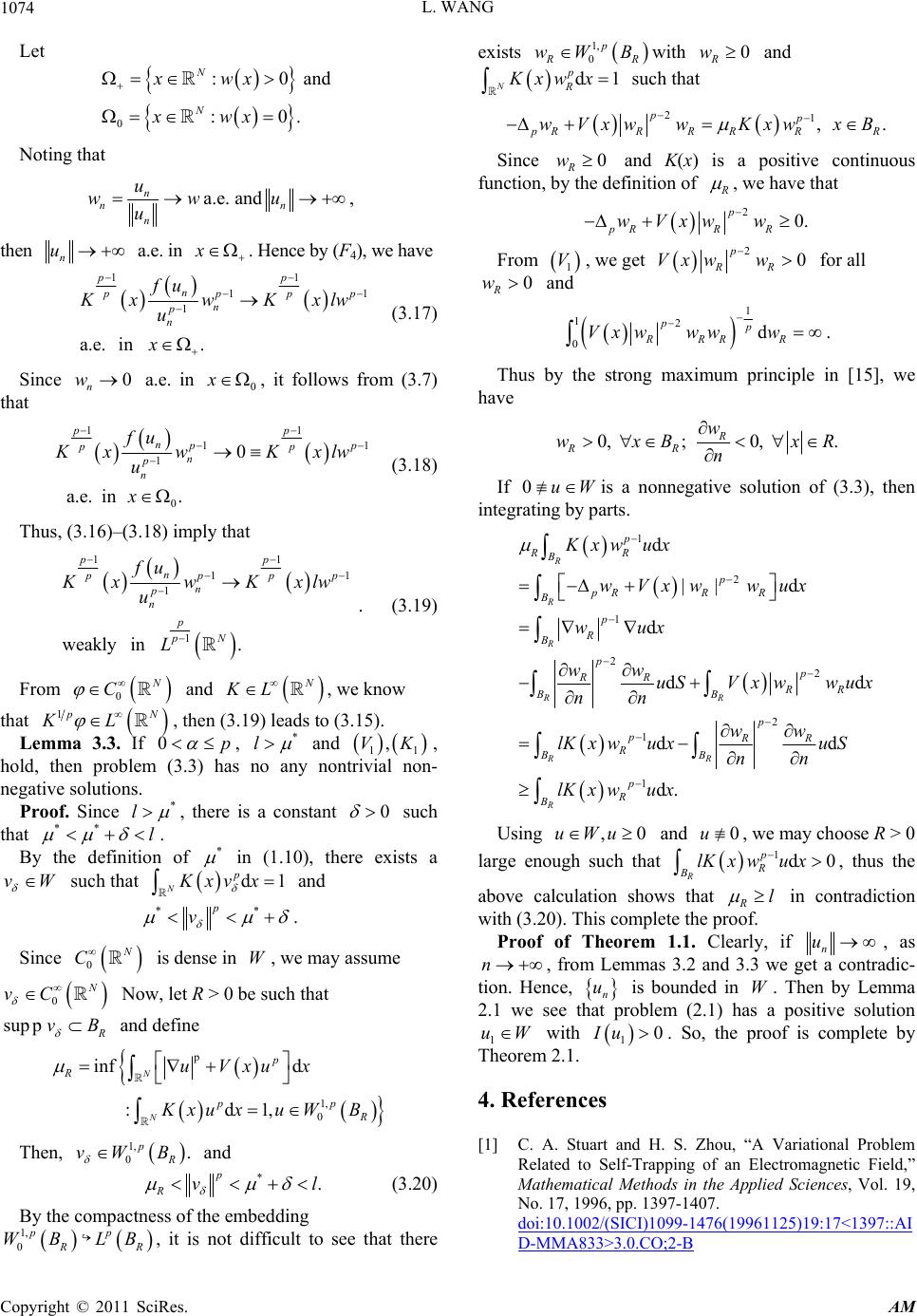 L. WANG 1074 Let 0 and x 0 : :0. N N xw xwx Noting that n n n u ww u a.e. andn u, then n u a.e. in x . Hence by (F), we have 4 11 11 1p n u (3.17) a.e. in. pp npp pp n fu Kxw Kxlw x Since a.e. in, it follows fro that 0 n w 0 x m (3.7) 11 1 n 11 0 0 a.e. in. pp p n p u pp n f xw u x Thus, (3.16)–(3.18) imply that Kxlw (3.18) 11 11 1n p n u 1 weakly in. pp npp pp p N p fu Kxw Kxlw L . (3.19) From and 0N C KL , we that know 1 pN KL , then (3.19) leads to (3.15). If Lemma 3.3. 0p , * l and 11 ,VK ld, then.3) haontrivial non- , ho problemy n e solutions. (3s no an negativ Proof. Since l* isstant , there a con0 suc f h that ** l . By the definition o * in (1.10), thists a t ere ex vW such tha d1 p Kxv x and N * p* v . 0N C ie maySince s dense in w assume Now, let R > 0 be suchat W, 0N vC th supp v define B and p f d N p uVxu x :Kx u 1, 0 in d1, N R pp R xuWB Then, and 1, 0. p R vW B *. p Rvl (3.20) compactness of the embedding By the 1, p 0 WB↪ p LB, it is nifficult to see that there exists ot d 1, 0 p R wW Bwith and 0 R w d1 N p R xw x such that 21, . pp RR R wVxw R RR wKxw xB Since positive continuous function,finition of 0 R w by the de and K(x) is a , we have that 20. p pRRR wVxw w From 1 V, we get 20 p R Vxw w for all 0w and R R 1 12 0d pp R Vxw . by th R R R www Thuse strong maximum principle in [15], we have 0, ; 0, . R RR n If w wxBxR 0uW is a nonnegative solution of (3.3), then integrating by parts. 1 2 || d R p pR BwV xw wux 1 2 2 2 1 1 d d dd dd d. R R RR RR R p RR B R R p R B p p RR RR BB p pRR R BB p R B Kxwux wux ww uSVx wwux nn ww lKx wu xuS nn lKx wu x Using ,0uWu andwe may choose R > 0 large enough such that , thus the above calculation shows that 0u , 1d0 R p R BlKxwu x Rl in contradiction w). This comp Proof of Theorem 1.1. Clearly, if ith (3.20lete the proof. n u, as 3.2 and 3.3 we get a n, from Lemmas contradic- tion. Hence, u is boumma n 2.1 we see that problem (2.1) positive solution 1 uW nded in . Then by Le h W as a with 0Iu . So, the pr 1 eorem 2.1. 4. Referenc A. Stua S. Zhou, “A Variational Problem Related to oof is complete by es [1] C.rt and H. Self-Trapping of an Electromagnetic Field,” Mathematical Methods in the Applied Sciences, Vol. 19, p. 1397-1407. ICI)1099-1476(19961125)19:17<1397::AI Th No. 17, 1996, p doi:10.1002/(S D-MMA833>3.0.CO;2-B Copyright © 2011 SciRes. AM 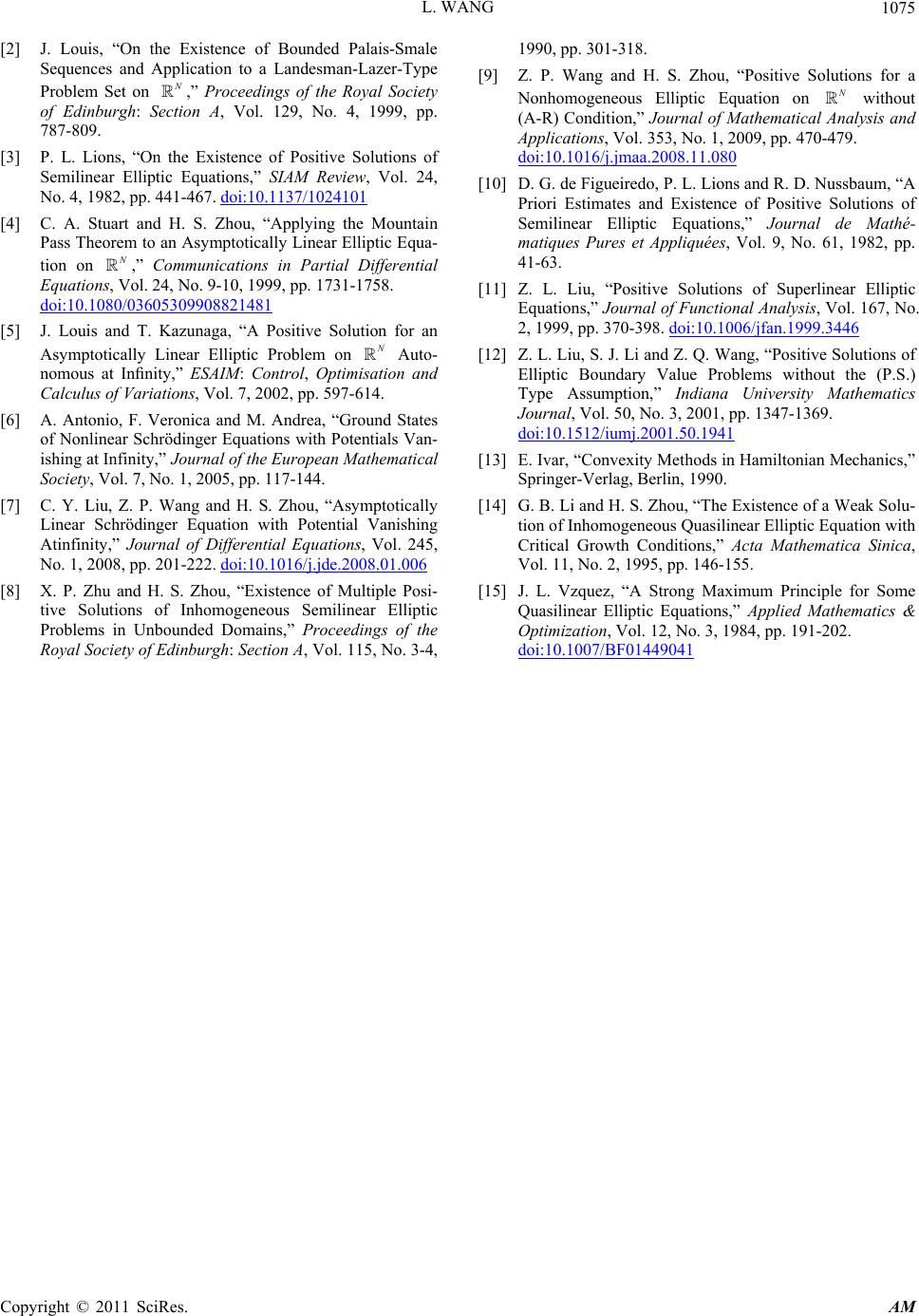 L. WANG Copyright © 2011 SciRes. AM 1075 . 129, No. 4, 1999, pp. tence of Positive Solutions of [2] J. Louis, “On the Existence of Bounded Palais-Smale Sequences and Application to a Landesman-Lazer-Type Problem Set on N ,” Proceedings of the Royal Society of Edinburgh: Section A, Vol 787-809. [3] P. L. Lions, “On the Exis Semilinear Elliptic Equations,” SIAM Review, Vol. 24, No. 4, 1982, pp. 441-467. doi:10.1137/1024101 [4] C. A. Stuart and H. S. Zhou, “Applying the Mountain Pass Theorem to an Asymptotically Linear Elliptic Equa- tion on N ,” Communications in Partial Differential Equations, Vol. 24, No. 9-10, 1999, pp. 1731-1758. doi:10.1080/03605309908821481 [5] J. Louis and T. Kazunaga, “A Positive Solution for an s with Potentials Van- Asymptotically Linear Elliptic Problem on N Auto- nomous at Infinity,” ESAIM: Control, Optimisation and Calculus of Variations, Vol. 7, 2002, pp. 597-614. [6] A. Antonio, F. Veronica and M. Andrea, “Ground St of Nonlinear Schrödinger Equation ates ishing at Infinity,” Journal of the European Mathematical Society, Vol. 7, No. 1, 2005, pp. 117-144. [7] C. Y. Liu, Z. P. Wang and H. S. Zhou, “Asymptotically Linear Schrödinger Equation with Potential Vanishing Atinfinity,” Journal of Differential Equations, Vol. 245, No. 1, 2008, pp. 201-222. doi:10.1016/j.jde.2008.01.006 [8] X. P. Zhu and H. S. Zhou, “Existence of Multiple Posi- tive Solutions of Inhomogeneous Semilinear Elliptic ournal of Mathematical Analysis and 1990, pp. 301-318. [9] Z. P. Wang and H. S. Zhou, “Positive Solutions for a Nonhomogeneous Elliptic Equation on N without (A-R) Condition,” J Applications, Vol. 353, No. 1, 2009, pp. 470-479. doi:10.1016/j.jmaa.2008.11.080 [10] D. G. de Figueiredo, P. L. Lions and R. D. Nussbaum, “A Priori Estimates and Existence of Positive Solutions of Semilinear Elliptic Equations, ” Journal de Mathé- , pp. 370-398. doi:10.1006/jfan.1999.3446 matiques Pures et Appliquées, Vol. 9, No. 61, 1982, pp. 41-63. [11] Z. L. Liu, “Positive Solutions of Superlinear Elliptic Equations,” Journal of Functional Analysis, Vol. 167, No. 2, 1999 matics [12] Z. L. Liu, S. J. Li and Z. Q. Wang, “Positive Solutions of Elliptic Boundary Value Problems without the (P.S.) Type Assumption,” Indiana University Mathe Journal, Vol. 50, No. 3, 2001, pp. 1347-1369. doi:10.1512/iumj.2001.50.1941 [13] E. Ivar, “Convexity Methods in Hamiltonian Mechanics,” Springer-Verlag, Berlin, 1990. [14] G. B. Li and H. S. Zhou, “The Existence of a Weak Solu- tion of Inhomogeneous Quasilinear Elliptic Equation with Critical Growth Conditions,” Acta Mathematica Sinica, pp. 191-202. Vol. 11, No. 2, 1995, pp. 146-155. [15] J. L. Vzquez, “A Strong Maximum Principle for Some Quasilinear Elliptic Equations,” Applied Mathematics & Optimization, Vol. 12, No. 3, 1984, Problems in Unbounded Domains,” Proceedings of the Royal Society of Edinburgh: Section A, Vol. 115, No. 3-4, doi:10.1007/BF01449041
|